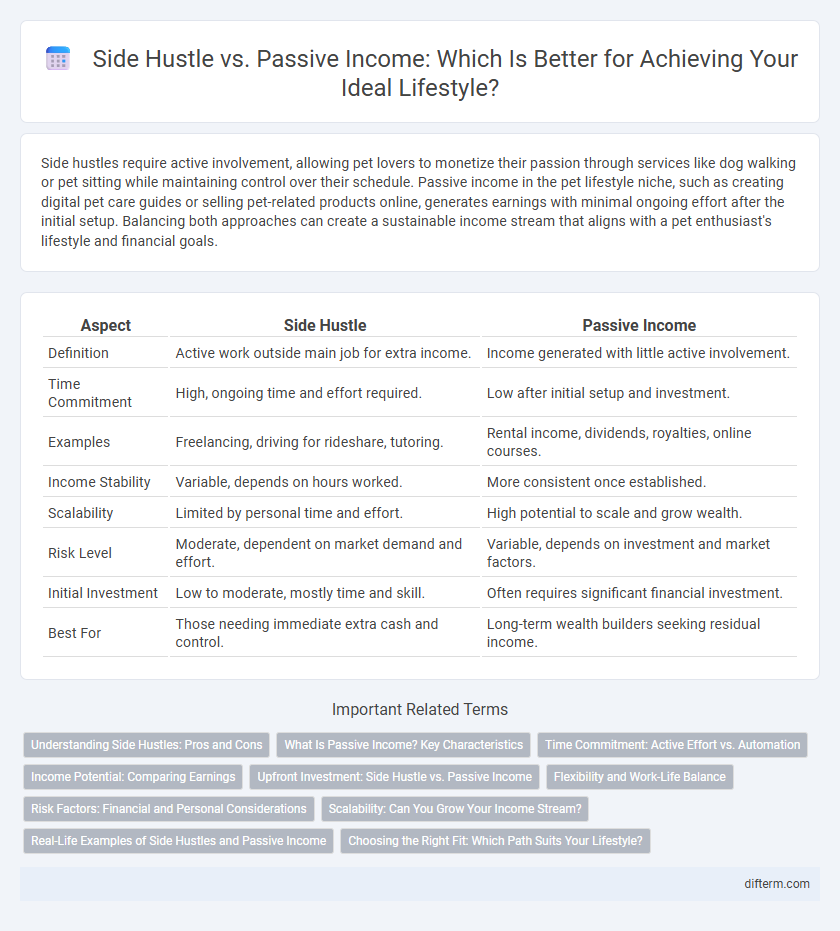Side hustles require active involvement, allowing pet lovers to monetize their passion through services like dog walking or pet sitting while maintaining control over their schedule. Passive income in the pet lifestyle niche, such as creating digital pet care guides or selling pet-related products online, generates earnings with minimal ongoing effort after the initial setup. Balancing both approaches can create a sustainable income stream that aligns with a pet enthusiast's lifestyle and financial goals.
Table of Comparison
| Aspect | Side Hustle | Passive Income |
|---|---|---|
| Definition | Active work outside main job for extra income. | Income generated with little active involvement. |
| Time Commitment | High, ongoing time and effort required. | Low after initial setup and investment. |
| Examples | Freelancing, driving for rideshare, tutoring. | Rental income, dividends, royalties, online courses. |
| Income Stability | Variable, depends on hours worked. | More consistent once established. |
| Scalability | Limited by personal time and effort. | High potential to scale and grow wealth. |
| Risk Level | Moderate, dependent on market demand and effort. | Variable, depends on investment and market factors. |
| Initial Investment | Low to moderate, mostly time and skill. | Often requires significant financial investment. |
| Best For | Those needing immediate extra cash and control. | Long-term wealth builders seeking residual income. |
Understanding Side Hustles: Pros and Cons
Side hustles offer flexible income opportunities by allowing individuals to leverage their skills outside of regular employment, enabling faster cash flow and skill development. However, they require significant time and energy investment, which can lead to burnout and limit scalability compared to passive income streams. Understanding these trade-offs helps in choosing between active effort and long-term, lower-maintenance earnings.
What Is Passive Income? Key Characteristics
Passive income is earnings generated with minimal effort, typically from investments, rental properties, or online businesses that operate autonomously. Key characteristics include consistent cash flow, scalability, and low active involvement, allowing individuals to earn money while focusing on other priorities. Unlike side hustles, passive income requires initial setup or investment but provides long-term financial stability and freedom.
Time Commitment: Active Effort vs. Automation
Side hustles demand significant active effort and ongoing time commitment, often requiring consistent hours dedicated to tasks and client interactions. Passive income relies on automation and initial setup, allowing money to flow with minimal daily involvement once systems or investments are in place. Balancing these models depends on one's available time, prioritizing active management for side hustles and strategic automation for passive revenue streams.
Income Potential: Comparing Earnings
Side hustles often offer variable income potential depending on time investment and skills, with earnings ranging from a few hundred to several thousand dollars monthly. Passive income streams, such as rental properties or dividend investments, typically generate more consistent earnings but require significant upfront capital or effort. Evaluating income potential involves balancing active work flexibility against long-term financial stability and scalability.
Upfront Investment: Side Hustle vs. Passive Income
Side hustles typically require a lower upfront investment, often involving time and existing skills rather than significant capital. Passive income streams such as real estate or dividend investing usually demand substantial initial funding to generate consistent returns. Balancing immediate effort with long-term financial commitment is essential when choosing between these income sources.
Flexibility and Work-Life Balance
Side hustles offer flexible work hours, allowing individuals to adapt activities around their primary job and personal commitments, enhancing work-life balance. Passive income streams, such as investments or rental properties, generate earnings with minimal ongoing effort, providing more freedom and reduced stress. Both options can improve financial stability while promoting lifestyle flexibility, but passive income typically requires upfront investment and time to establish.
Risk Factors: Financial and Personal Considerations
Side hustles often require upfront investment and active time commitment, increasing financial risk and personal stress levels due to juggling multiple responsibilities. Passive income streams typically involve initial capital or expertise but tend to have lower ongoing risk, providing more financial stability and personal freedom. Evaluating risk factors such as cash flow variability, time allocation, and impact on work-life balance is crucial when choosing between side hustle and passive income opportunities.
Scalability: Can You Grow Your Income Stream?
Side hustles often require continuous active effort, which limits scalability and caps income growth potential. Passive income streams, such as investments or royalties, offer scalability by generating earnings with minimal ongoing work, allowing for exponential income increase over time. Leveraging scalable passive income models enables greater financial freedom compared to side hustles bound by time constraints.
Real-Life Examples of Side Hustles and Passive Income
Freelance graphic design and ride-sharing services exemplify popular side hustles that generate active income through direct time investment. Rental properties and dividend stock portfolios provide passive income streams, yielding earnings with minimal daily involvement. Case studies reveal side hustlers often transition into passive income by reinvesting profits into automated ventures like online courses or real estate management services.
Choosing the Right Fit: Which Path Suits Your Lifestyle?
Side hustles demand active time investment and offer flexibility for immediate earnings, making them ideal for individuals seeking hands-on income streams alongside their primary job. Passive income, generated through investments such as rental properties or dividend stocks, suits those aiming for long-term financial freedom with minimal daily effort. Assessing your available time, risk tolerance, and financial goals helps determine whether a side hustle's engagement or passive income's sustainability aligns better with your lifestyle.
Side Hustle vs Passive Income Infographic

 difterm.com
difterm.com